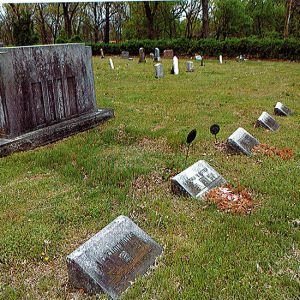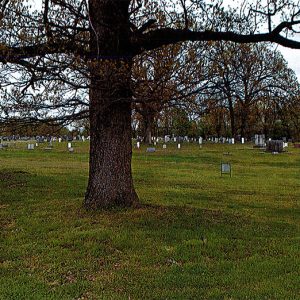calsfoundation@cals.org
Elm Springs Cemetery, Historic Section
The Elm Springs Cemetery, Historic Section, is located in the community of Elm Springs (Washington and Benton counties). The date of the first marked burial is 1852. The site was listed on the National Register of Historic Places on November 5, 2020.
A Methodist church was founded in Elm Springs in 1832, and many of the founding church members are buried in the Historic Section. The first Methodist church building was built in 1850, adjacent to the cemetery’s location. Therefore, many unmarked burials or burials simply marked with fieldstones may be earlier than 1852. The Elm Springs Cemetery, Historic Section, is approximately 3.75 acres. The entrance of the cemetery is marked with a large sign with the name of the cemetery held in place by two bricked pillars. A distinctive feature of the Historic Section are several very old and large trees, some of which may have been in existence since the first marked burial.
The land was originally part of a U.S. Land Patent and also part of Choctaw Scrip Land acquired by early settlers John Ingram and William Barrington. The majority of people who are buried in the Historic Section were early residents of the Elm Springs community and nearby areas, which were settled in 1832. Many of those buried in the Historic Section are businesspeople and ministers, along with several Civil War veterans. Many descendants of the early settlers are also buried in the Historic Section.
The Elm Springs Cemetery, Historic Section, has many hand-carved sandstone markers, marble markers, and ornate family name stones dating from the nineteenth and early twentieth centuries. Margaret Rebecca (Wilt) Deaver (1794–1852) appears to be the earliest burial marked with a commercial marker fashioned at the time. Her burial is followed by that of William Barrington (1808–1853). Many pioneer families are buried in the Historic Section, including others from the Deaver and Barrington families, as well as the Steele family, Ritter family, Greathouse family, McCamey family, Sturdy family, Glover family, and Pearson family.
The gravestones are fine examples of nineteenth- and early-twentieth-century iconography and early hand-carved and stone masonry work. Many of the marble and granite headstones contain Masonic symbols, gateways, archways, floral motifs, and crosses, including one Confederate States of America iron cross. Some headstones have large, ornate headstones with intricate designs, though most throughout the Historic Section are modest with simple patterns. Several headstones are carved with a mark or signature of the stonemason. Others are unreadable due to the age and weathering. There are several obelisks throughout the section and one crypt. Some of the gravestones are broken, and several have been hit by mowers.
The location, design, and setting of the cemetery have remained unchanged, even as it has expanded over the years. It is easy to differentiate the Historic Section from the newer sections to the north, since the gravestones’ designs are indicative of a different era. Despite its age, the cemetery is in excellent condition and is well maintained.
For additional information:
“Elm Springs Cemetery, Historic Section.” National Register of Historic Places registration form. On file at Arkansas Historic Preservation Program, Little Rock, Arkansas. Online at http://www.arkansaspreservation.com/National-Register-Listings/PDF/WA1716.nr.pdf (accessed December 1, 2022).
Michael Freels
Gentry, Arkansas
Pat Ashbaugh
Springdale, Arkansas
 Historic Preservation
Historic Preservation Louisiana Purchase through Early Statehood, 1803 through 1860
Louisiana Purchase through Early Statehood, 1803 through 1860 Elm Springs Cemetery Entrance
Elm Springs Cemetery Entrance  Elm Springs Cemetery Gravestones
Elm Springs Cemetery Gravestones  Elm Springs Cemetery Grounds
Elm Springs Cemetery Grounds  Elm Springs Cemetery Monument
Elm Springs Cemetery Monument 




Comments
No comments on this entry yet.